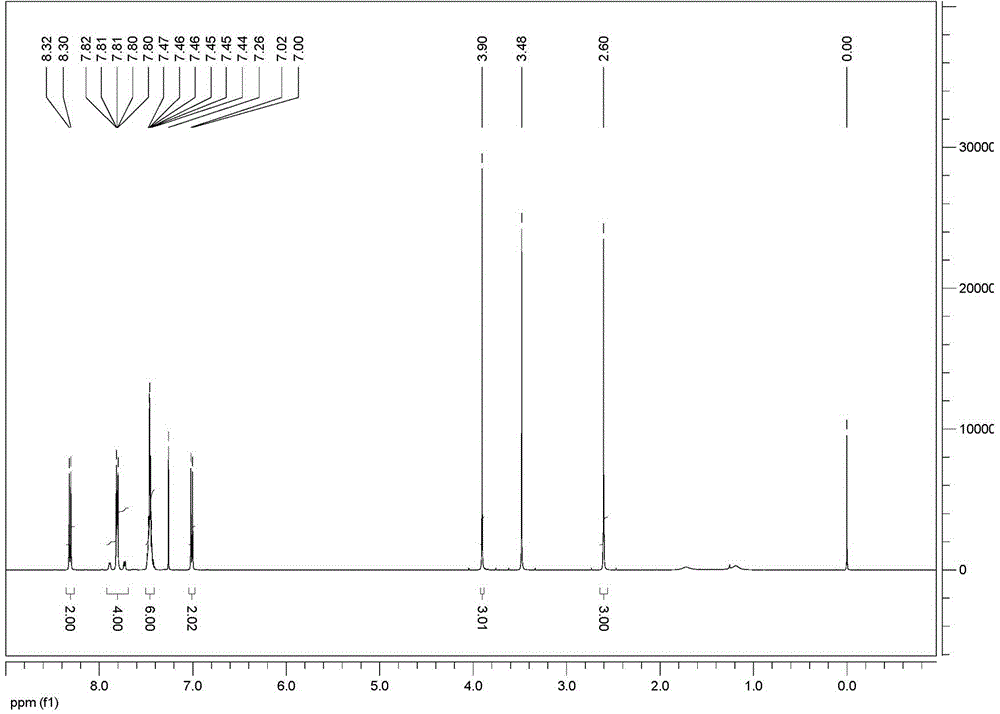2-oxo-propionic acid p-methoxyl benzoyl hydrazone diphenyl tin complex and preparation method and application thereof
A technology of methoxybenzoylhydrazone diphenyltin and carbonylpropionic acid, which is applied in the application field of preparing anticancer drugs, can solve the problems of undiscovered compounds, etc., and achieve simple preparation methods, good anticancer activity, and low cost. low effect
- Summary
- Abstract
- Description
- Claims
- Application Information
AI Technical Summary
Problems solved by technology
Method used
Image
Examples
Embodiment 1
[0042] Preparation of 2-oxopropionic acid p-methoxybenzoylhydrazone diphenyltin complex:
[0043] Add 0.344g (1.0mmol) diphenyltin dichloride, 0.166g (1.0mmol) p-methoxybenzohydrazide, 0.115g (1.05mmol) sodium pyruvate and 15mL The solvent is anhydrous methanol, reacted for 8 hours at a temperature of 50~65°C, cooled, filtered, and controlled solvent volatilization and crystallization at a temperature of 20~35°C to obtain a yellow transparent crystal, which is 2-carbonylpropionic acid p-formaldehyde Oxybenzoylhydrazone diphenyltin complexes. Yield: 87.2%. Melting point: 96~98°C (dec).
[0044] Elemental analysis (C 48 h 48 N 4 o 10 sn 2 ): Calculated: C 53.46, H 4.49, N 5.20; Found: C 53.50, H 4.51, N 5.21.
[0045] FT-IR (KBr, ν / cm -1 ): 3448, 3055, 2956, 2933, 2837, 1687, 1602, 1479, 1386, 1253, 1170, 1072, 844, 731, 696, 626, 594, 541, 511, 455.
[0046] 1 H NMR (500 MHz, CDCl 3 , δ / ppm): 8.31 (d, J =9.0 Hz, 2H), 7.80-7.82 (m,4H), 7.44-7.47 (m, 6H), 7.01 (d, ...
Embodiment 2
[0051] Preparation of 2-oxopropionic acid p-methoxybenzoylhydrazone diphenyltin complex:
[0052] Add 0.344g (1.0mmol) diphenyltin dichloride, 0.174g (1.05mmol) p-methoxybenzohydrazide, 0.126g (1.15mmol) sodium pyruvate and 35mL The solvent is anhydrous methanol, react for 5 hours at a temperature of 50~65°C, cool, filter, and control the solvent volatilization and crystallization at a temperature of 20~35°C to obtain a yellow transparent crystal, which is 2-oxopropionic acid p-formaldehyde Oxybenzoylhydrazone diphenyltin complexes. Yield: 86.0%. Melting point: 96~98°C (dec).
[0053] Elemental analysis (C 48 h 48 N 4 o 10 sn 2 ): Calculated: C 53.46, H 4.49, N 5.20; Found: C 53.50, H 4.51, N 5.21.
[0054] FT-IR (KBr, ν / cm -1 ): 3448, 3055, 2956, 2933, 2837, 1687, 1602, 1479, 1386, 1253, 1170, 1072, 844, 731, 696, 626, 594, 541, 511, 455.
[0055] 1 H NMR (500 MHz, CDCl 3 , δ / ppm): 8.31 (d, J =9.0 Hz, 2H), 7.80-7.82 (m,4H), 7.44-7.47 (m, 6H), 7.01 (d, J =9.0 H...
Embodiment 3
[0060] Preparation of 2-oxopropionic acid p-methoxybenzoylhydrazone diphenyltin complex:
[0061] Add 1.720g (5.0mmol) diphenyltin dichloride, 0.847g (5.1mmol) p-methoxybenzohydrazide, 0.605g (5.5mmol) sodium pyruvate and 25mL Solvent anhydrous methanol, react for 20 hours at a temperature of 50~65°C, cool, filter, and control solvent volatilization and crystallization at a temperature of 20~35°C to obtain a yellow transparent crystal, which is 2-carbonylpropionic acid p-formaldehyde Oxybenzoylhydrazone diphenyltin complexes. Yield: 85.8%. Melting point: 96~98°C (dec).
[0062] Elemental analysis (C 48 h 48 N 4 o 10 sn 2 ): Calculated: C 53.46, H 4.49, N 5.20; Found: C 53.50, H 4.51, N 5.21.
[0063] FT-IR (KBr, ν / cm -1 ): 3448, 3055, 2956, 2933, 2837, 1687, 1602, 1479, 1386, 1253, 1170, 1072, 844, 731, 696, 626, 594, 541, 511, 455.
[0064] 1 H NMR (500 MHz, CDCl 3 , δ / ppm): 8.31 (d, J =9.0 Hz, 2H), 7.80-7.82 (m,4H), 7.44-7.47 (m, 6H), 7.01 (d, J =9.0 Hz, 2H),...
PUM
| Property | Measurement | Unit |
|---|---|---|
| melting point | aaaaa | aaaaa |
Abstract
Description
Claims
Application Information
 Login to View More
Login to View More - R&D
- Intellectual Property
- Life Sciences
- Materials
- Tech Scout
- Unparalleled Data Quality
- Higher Quality Content
- 60% Fewer Hallucinations
Browse by: Latest US Patents, China's latest patents, Technical Efficacy Thesaurus, Application Domain, Technology Topic, Popular Technical Reports.
© 2025 PatSnap. All rights reserved.Legal|Privacy policy|Modern Slavery Act Transparency Statement|Sitemap|About US| Contact US: help@patsnap.com



